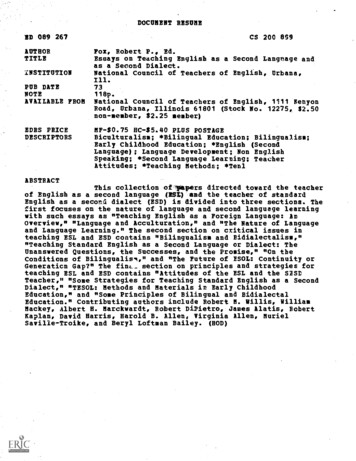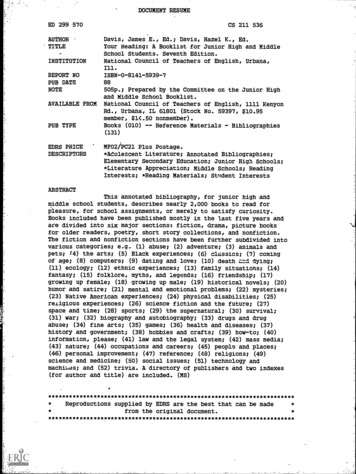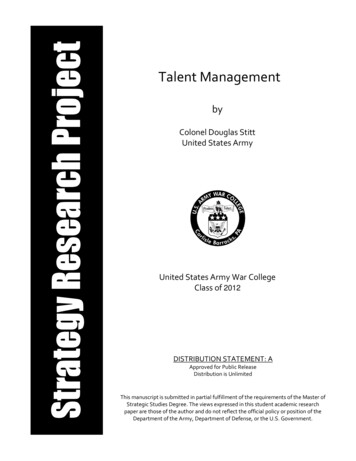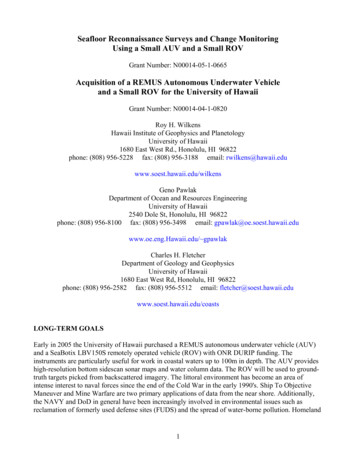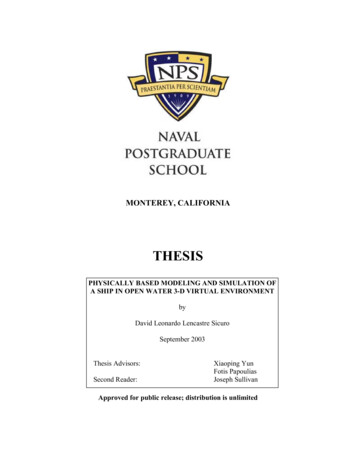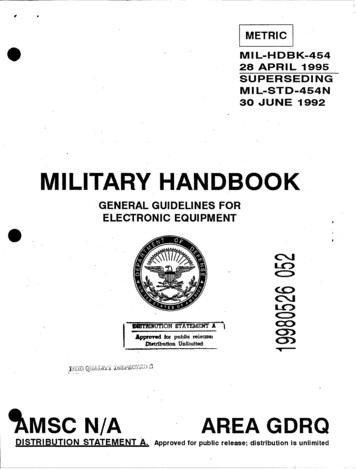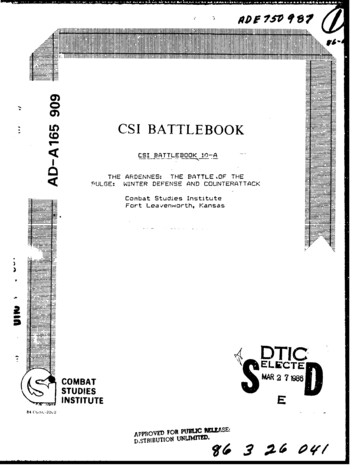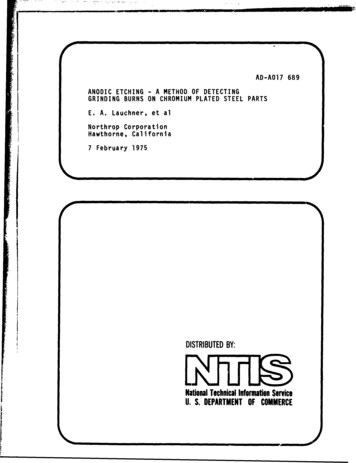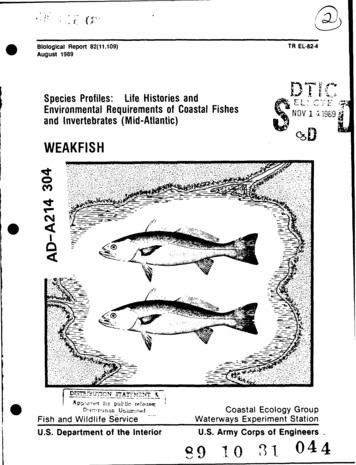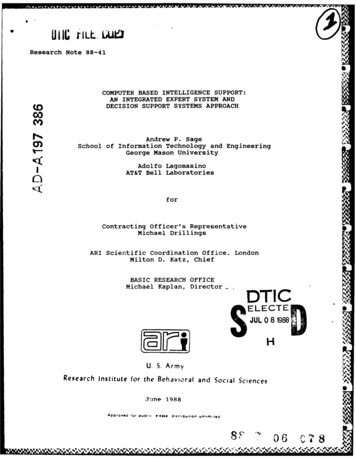
Transcription
"UilI iLL, WOJResearch Note 88-41toCOMPUTER BASED INTELLIGENCE SUPPORT:AN INTEGRATED EXPERT SYSTEM ANDDECISION SUPPORT SYSTEMS APPROACH000)Andrew P. SageSchool of Information Technology and EngineeringGeorge Mason UniversityAdolfo LagomasinoAT&T Bell LaboratoriesforContracting Officer's RepresentativeMichael DrillingsARI Scientific Coordination Office. LondonMilton D. Katz, ChiefBASIC RESEARCH OFFICEMichael Kaplan, DirectorICDTELECTEJUL 0 81988HU. S. ArmyResearch Institute for the Behavioral and Social SciencesJune 1988Aorev@edfout)cetiOtd'Itr, O)utgoUnlited(. 5 '7 06C 8
U. S. ARMY RESEARCH INSTITUTEFOR THE BEHAVIORAL AND SOCIAL SCIENCESA Field Operating Agency under the Jurisdiction ot theDeputy Chief of Staff for PersonnelWM. DARRYL HENDERSONCO)L, INCommandingEDGAR M. JOHNSONTechnical MirctorResearch accomplished under contractfor the Department of the ArmyGeorge Mason UniversityTechnical review byDan Raglandas the National Technical Information service INTis). The views. opinions, and/or findings contained in thisrepot houdae toseofnt bte costrudotho s)anda anoffcialDeprtrentof te A my osiionPoliy. b- '
UNCLASSIFIEDSECURITY CLASSIFICATION OF THIS PAGE (When Data Entered)REPORT DOCUMENTATION PAGE PAGE3.RECIPIENT'S CATALOG NUMBERTITLE (mid Subtitle)S.TYPE OF REPORT & PERIOD COVEREDComputer Based Intelligence Support:An Integrated Expert Systems andInterim ReportOctober 84 - October 852. GOVT ACCESSION NO.1. REPORT NUMBERARI Research Note 88-4114.S.6. PERFORMING ORG. REPORT NUMBERSystems ApproachDecision Support7.READ INSTRUCTIONSBEFORE COMPLETING FORMAUTHOR(s)S. CONTRACT OR GRANT NUMBER(*)Andrew P. Sage and Adolfo LagomasinoMDA903-82-C-0124PERFORMING ORGANIZATION NAME AND ADDRESS10. PROGRAM ELEMENT. PROJECT. TASKAREASchool of Information Technology and Engineering,12.II. CONTROLLING OFFICE NAME ANC ADDRESSREPORT DATEJune 198813. NUMBEROF PAGESU.S. Army Research Institute for the Behavioraland Social Sciences, 5001 Eisenhower Avenue,22333-5600Alxandria. VA14.WORK UNIT NUMBERS2QI6iI02B74FGeorge Mason University22030Fairfax, VA29MONITORING AGENCY NAME & ADDRESS(f different from Controlling Office)IS. SECURITY CLASS. (of thl report)UnclassifiedIS&. DECL ASSI FICATION/DOWNGRADINGSCHEDULEIS.DISTRIBUTION STATEMENT (of this Report)Approved for public release; distribution unlimited.17. DISTRIBUTION STATEMENT (of the abstract entered in Block 20, Ifdifferent from Report)IS. SUPPLEMENTARY NOTESMichael Drillings, contracting officer's representative19.KEY WORDS (Continue on teerse side if neceeeary and identify by block number)Knowledge Representation,Expert Systems.Artificial Intelligence.Intelligence. Cognitive Science:20 AmETVIACT (CetAe sreverse stN feestatda t#r by block nmmber)I This research note summarizes research and design needs in the area ofcomputer bascd intelligence support, particularly the command and controlarea. It is argued that an integrating approach is needed. A discussionof knowledge representation emphasizes this, and an approach that accomodatesboth probabhtli1-ic and logical support, and which is able to cope with severaltypes of imperfect information is described.DOr1473EMoITIOI NOV s ISOBSOLETE"-TI Nr',T.A-qqTTF niSECURITY CLASSFICATtON OF THIS PAGE (When Date Entered)3-S
Computer Based Intelligence Support:An Integrated Expert Systems and Decision Support Systems ApproachbyANDREW P. SAGESchool of Information Technology and EngineeringGeorge Mason UniversityVAFairfax22030ADOLFO LAGOMASINOAT&T Bell LaboratoriesHolmdel,Thispaper summarizesNJresearch and design needsforIntelligence based support, especially in areas of command andcontrol.It argues strongly for an approach that integrates,especially In the areas of inference analysis, contemporaryapproaches in artificial intelligence for expert systemconstruction andapproachesformanagement ingsystems.Adiscussion of knowledge representation and Information processinghighlights needs for this.An approach that accommodates bothprobabilistic and logical support, and which is able to cope withseveral types of imperfect information In described.first draft:revised:inNovember 11, 1984October 20, 1985Expert Systems for Managers,in ArtificialB.G. Silverman (ED),Intelligence and ManagementTIMS seriesScience,AddisonWesley.The research described here was supported by by the U. S. ArmyResearch Institute under Contract MDA 903-82-C-0124.1. 4,e w
1. ecomputerimplemented procedures that seek to combine expert izingandThey Integrate this with "formal"reasoning about that domain.methods of reasoning about the domain. The Inferential power ofQ. .-.z:z;utcr programs rests upon a knowl&c-LMputtogether factual information about the domain with the heuristicsor informal "rules of thumb" experts use to rapidly findsolutions to problems and with the formal reasoning methods thatare needed when approaching an unstructured problem about whichexperiential familiarity is slight.The goal of an Intelligent system for decision support is toencode in a computer program the facts an expert has and tlmethods of reasoning about them, together with formal method:reasoning about unstructured situations. In that sense, anintelligent system may be viewed as a descriptive model of anexpert reasoning process about a problem domain and a normativesystem to aid in formal reasoning when this expertise does notexist. Although intelligence support systems have the potentialof encoding cognitive biases or prejudice, they may be veryattractive to planners and decision makers because they could beset up as on-line decision support systems in situations wheretime limitations are an important factor. There are methods,currently under Investigation, that enable detection ofinconsistent reasoning and It is hoped that such efforts may beextended to enable detection of, at least some, of the identifiedcognitive biases associated with human Information processing.2. Knowledge Representation and Processing in Decision SupportSystems DesignApproaches that will enable effective knowledgerepresentation, and associated inference activities, In largeknowledge bases have been the subject of investigation for manyresearchersAnappropriaterepresentationdescribe thefour different types of factualthatcapturedmaybein aknowledgeperformance, and metaknowledge.base:canbeusedtoLiknowledge elementsobjects,events,It will assist In IdentificationorcfD1AtCodes1.- .L lori Special1
of the values that need to be associated with facts In order toenable judgment and choice.The purpose of a particulariknowledge representation Is to enable the use of knowledge for:retrieving factual information from the knowledge base that isjudged relevant to the task at hand, reasoning about these factsin the search for a resolution of the task requirements, epresentation of knowledge as they apply to the control andgeneration of dialogue for human-system interaction are discussedin Sage and Lagomasino [1984].2.1 Knowledge Base Management System [KBMS]A knowledge base management system is one ofthe threefundamental components of an Intelligent system for decisionsupport. In almost every Instance in which there will existmultiple decisionmakers, there will exist the need for Individualknowledge bases and organizational knowledge bases. Some of thedesirable characteristics of a DBMS Include the ability to copewith a variety of data structures that allow for probabilistic,Incomplete, imprecise, and other forms of imperfect data; anddatathatisunofficial,andofficial and organizational.In order to constructnecessary torepresentationpersonal,ascontrasteda knowledge base,it iswithfirstidentify a knowledge representation scheme. Aschemeisacollectionofdatastructures,operations that may be applied on the data structures,andintegrity rules which are use to constrain or otherwise definepermissible values of the data.There are atleast five modelsthat may be used to represent data.The most elementary of theseIs theThe relationalIndividualrecord model.powerful generalization of the record model.modelis aA relation is thefundamental data structure in the relational model, and there maybe a number of fields In any given relation.The relationalmodel enables mathematical set operations in terms of addition ofnew records, updating fields within existing records, creatingrelations that may be contained in records, deleting relationsthat may be contained in records, joining or combining two ormore relations based on their containing common fields, selectingI
recordsbyvirtueoftheircontaining certainspecifiedrelations, and projection such as to enable selection of a subsetof the fields that exist in a relation.The hierarchicalortree dataefficient representation of data.modelisarelativelyIn a hierarchicalmodel,thestructure represents the information that is contained in thefields of a relational model.In a hierarchical model, therewill be certain records which must exist before other records canexistsinceBecause ofeverythisdatastructuremuststructured aspectofhavetheamodel,rootitrecord.willbenecessary to repeat some of the data that need be stored ralization of the hierarchical model in that there are linksbetween records which enables a given record to participate inseveral relationships.There are often major problems associatedwith insertions, deletions, and updating in both the hierarchicaland network data models due to the need to maintain a consistentdata base. These do not exist in the relational model since thesame al search complexity since a search can start anywhere inthe network structure.Searches are, however, generally moreefficient than they are In the relational model.Due to the need to accommodate Intelligent capabilities in adecision support system, it is desirable to consider a productionrule model as a fifth data model.be made.modelThus this is a particularly desirable form of datawhenwedesiretouseinformation system capabilities."what if"This will enable inferences tomany predictiveThemanagement"if then" type responsequeries is especially naturaltoin this representation.As will be shown, this representation allows for efficient metalevelcontrol,productionthrough decision support type approaches, of therulesinanexpertsystemknowledgebase.Knowledge representation formats also include frame, script, andschema representations.These representations are muchlike thecognitive maps that humans construct of the world around them.Atthis point,there does not seem to exist operational datamodels based on these representations, and surely this is an areaof contemporary research need.Additional discussion of data4mom
base management management system [DBMS] design approaches can befound in Sprague and Carlson [1982], and Date [1977, 1983].Thethree volume Handbook of Artificial Intelligence edited by Barr,Cohen and Feigenbaum [1981,1982]and the text by Sowa [1984]discuss knowledge representation from an Al perspective. .2 MQel Base Management System [MBMS]Itisnecessary to provideintelligent system.inference capabilityThis requires some sort of modelmanagement system [MBMS].in anbaseIt is through the use of model basemanagement systems that we are able to provide for sophisticatedanalysis and Interpretation capability in a decision supportsystem.The single most Important characteristic of a model basemanagement system is that It should enable the decisionmaker toexplore the decision situation through use of the knowledge baseby a model base or algorithmic procedures and elingstatements, In some procedural or nonprocedural language, throughthe use of the model subroutines, such as mathematicalprogramming packages, that are called by a management function,and through the use of data abstraction models. This approachfacilitates updating and use of the model for explanatory andexplication purposes.The use of multiple models can potentially accommodate thedesire of the typical decisionmaker for flexibility. Thus amixed scanning approach might be incorporated in which aconjunctive or disjunctive scanning mechanism is used to allowfor an Individual scan to eliminate grossly unacceptablealternatives.After this is accomplished, further evaluation ofalternatives might be accomplished by a compensatory tradeoffevaluation, or one based on a dominance search procedure [Sageand White, 1984].To provide flexibility, the MBMS should provide, upon systemuser request, a variety of prestructured models that have beenfound useful in the past, such as linear programming andmultiattribute decision analysis model, and procedures to usethese models. It should also allow for the development of userbuilt models and heuristics that are developed from established
models that will either become permanent parts of the MBMS orwhich will be considered as ad hoc models. It should also bepossible to perform sensitivity tests of model outputs, and torun models with a range of data to obtain the response to avariety of what if type questions.2.3 Dialogue Generation and Management System [DGMS]The dialogue generation and management system portion of adecision support system Is designedto satisfy knowledgerepresentation, and control and Interface requirements of theintelligent system for decision support. It is the DGMS that isresponsible for presentation of the outputs of the system to thedecisionmaker and for determining, acquiring, and transmittingtheir inputs to the KBMS and the MBMS based on Its knowledgeaboutthe decisionmaker's goals aboutthe specific decisionsituation. Thus the DGMS is responsible for producing outputrepresentations, for obtaining the decisionmaker inputs thatresult in the operations on the representations, for interfacingto the memory aids, and for explicit provision of the controlmechanism that enable effective dialogue between the user and theKBMS and MEMS.There are a number of possible dialogues. These areinherently linked to the representational forms that are used forthe DBMS and MBMS. Menus, spreadsheets, tradeoff graphs, andproduction rules are some of the formats that may be used as abasis for dialogue system design. Generally, several of theseshould be used as the support system user may wish to shift amongtheseformatsasthefamiliarity with thenatureissuesofissuesandexperientialchanges. The DGMSshould besufficiently flexible such as to allow review and sensitivityanalysis of past judgments, and to provide partial judgmentsbased upon Incomplete information. Of course, the DGMS should be"user friendly" through provision of various HELP facilities,prompting the decisionmaker, and other abilities that supportsthe knowledge of the support system user.6 .A
3. Management of Intelligent SystemsLimits associated with the cognitive capacity ofthe humanmind, time limitations, and many other competing concerns of thedecisionmaker are constraintsthat affect adequateformulation,analysis, and interpretation of complex large scale issues. Adesign goalfor Intelligent systems and processes that willa,*i.L in various problem solving tasks is to reduce, to theextent possible, the effects of the aforementioned constraints soas to enable the efficient and effective use of information thatwill lead to quality judgments in routine and familiar taskenvironments and in unfamiliar task conditions.An appropriateorganized andinframeworkwhichknowledgecouldbeutilized efficiently and effectively is desired.This is especially needed as studies have shown that the way inwhich a task is framed exerts a very strong influence upon theway in which task requirements and task resolution efforts aredetermined [Kahneman, Slovic and Tversky, 1982; Sage, 1981]. Thisrequires that we be able to address the modeling of Intelligentsystems for decision support from several perspectives. OurInterest here is to describe implications that arise in thedesign of Intelligent systems for decision support icularInterest will be those components at the Interface between thecognitive process level of systems management and the problemlevel, and at the knowledge metalevel which will enable effectivemodeling of the intelligent system itsela.3.1 The Problem LevelAt the problem level In the systems management process,there are a number of abilities that an Intelligent system fordecision support should have. It should assist the decisionmakerIn the formulation or framing of the decision situation in thesense of recognizing needs, identifying appropriate objectives bywhich to measure the successful resolution of an Issue, andgenerating alternative courses of action that willresolve theneeds and satisfy objectives. It should also provide support Inenhancing the abilities of the decisionmaker to obtain thepossible Impacts on needs of the alternative courses of action,7A.V-1-%A
and to understand systems behavior. This analysis capability mustbe associated with provision of capability to study the ialintervention as to enhance the ability of the decisionmaker toprovide an interpretation of these impacts in terms of predefinedand evolving objective measures. This Interpretation capabilitywill lead to evaluation of the alternatives and selection of apreferred alternative option. Associated with these must be theabilitytoacquire,represent,and utilizeinformation orknowledge, and the ability to implement the chosen alternativecourses of action. All of this must be accomplished with dueconsideration with the particular rationality perspective that isused for decisionmaking.I3.2 Cognitive Process LevelSeveral intelligent systems design complexities arise at thecognitive process level of systems management. These relate tothe forms, frames, or perspectives associated with acquiring,Integrating, and applying vast amounts of knowledge. These formsrange from the systemic framework of formulation, analysis, andinterpretation at the problem level that is characteristic offormal operational or holistic thought, to intuitive affect thatis characteristic of concrete operational and wholistic thought.The reasoning perspectives Invoked at the cognitive process leveloforoblem resolution depend upon the task requirements, theexperiential familiarity of the decisionmaker with the task, andthe rationality perspectives that are used for task resolution[Sage, 1981,4. Knowledge1982;Linstone, ion SupportVarious assumptions about the nature and characteristic ofthe contingency structural elements of task, environment, andhuman problem solverfamiliarity withthese areconsideredessential in the design of intelligent systems in order to enableeffective and efficient organization of knowledge about specificsituation domains. Due to these assumptions, not all specificdomains of knowledge are suitablefor building intelligent
systems for decision support. Gevarter [1984]Identifies severalcharacteristics that a domain of knowledge must satisfies attheknowledge level in order to allow an Intelligent system to bebuilt that is based onl, on expert acknowledged to perform the task well.iTho b primary sources of thqm!vr-t'P!!Ities must bespecial knowledge, judgment, and experience.(3) The expert must be able to articulate that specialknowledge, judgment, and experience and also explainthe methods used to apply it to a particular task.(4) The task must have a well-bounded domain of application.There will exist many situations in which these requisiteconditions are not satisfied. A decision support system Is ageneric dual of an expert syst
.2 MQel Base Management System [MBMS] It is necessary to provide inference capability in an intelligent system. This requires some sort of model base management system [MBMS]. It is through the use of model base management systems that we are able to provide for sophisticated analysis an

